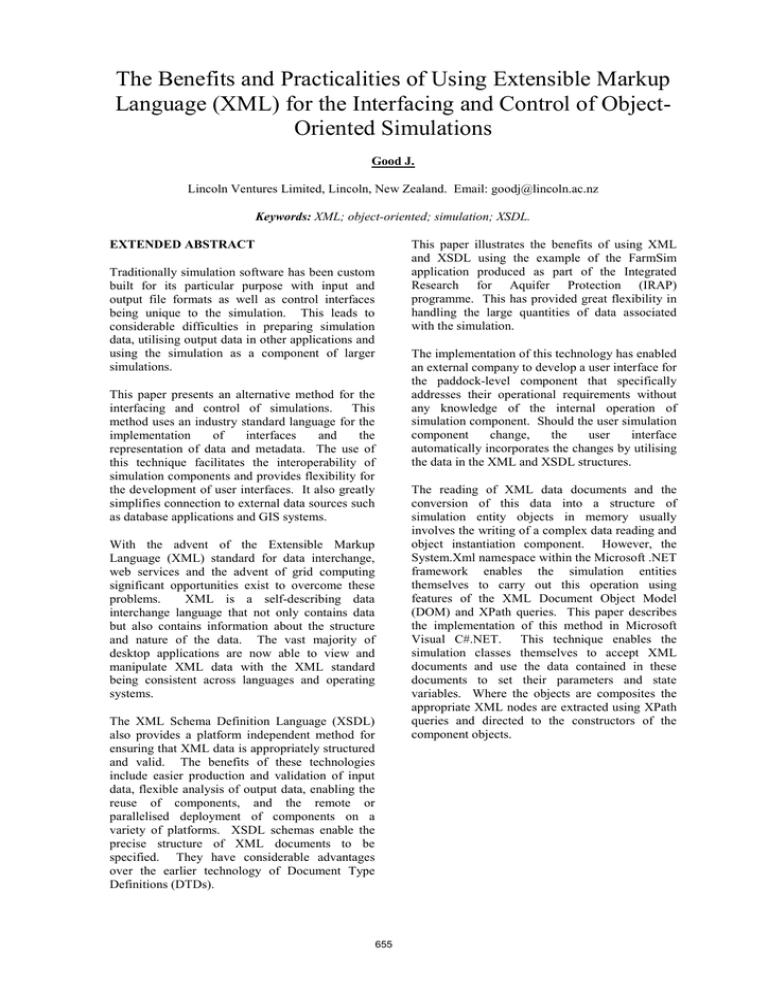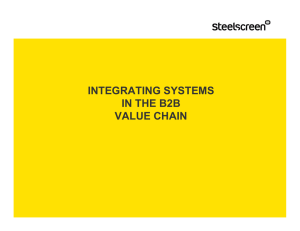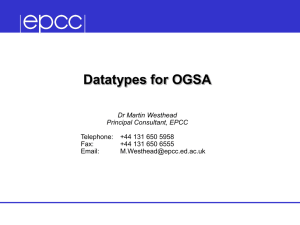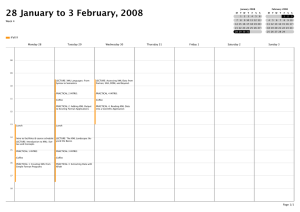The Benefits and Practicalities of Using Extensible Markup
advertisement

The Benefits and Practicalities of Using Extensible Markup
Language (XML) for the Interfacing and Control of ObjectOriented Simulations
Good J.
Lincoln Ventures Limited, Lincoln, New Zealand. Email: goodj@lincoln.ac.nz
Keywords: XML; object-oriented; simulation; XSDL.
This paper illustrates the benefits of using XML
and XSDL using the example of the FarmSim
application produced as part of the Integrated
Research for Aquifer Protection (IRAP)
programme. This has provided great flexibility in
handling the large quantities of data associated
with the simulation.
EXTENDED ABSTRACT
Traditionally simulation software has been custom
built for its particular purpose with input and
output file formats as well as control interfaces
being unique to the simulation. This leads to
considerable difficulties in preparing simulation
data, utilising output data in other applications and
using the simulation as a component of larger
simulations.
The implementation of this technology has enabled
an external company to develop a user interface for
the paddock-level component that specifically
addresses their operational requirements without
any knowledge of the internal operation of
simulation component. Should the user simulation
component
change,
the
user
interface
automatically incorporates the changes by utilising
the data in the XML and XSDL structures.
This paper presents an alternative method for the
interfacing and control of simulations. This
method uses an industry standard language for the
implementation
of
interfaces
and
the
representation of data and metadata. The use of
this technique facilitates the interoperability of
simulation components and provides flexibility for
the development of user interfaces. It also greatly
simplifies connection to external data sources such
as database applications and GIS systems.
The reading of XML data documents and the
conversion of this data into a structure of
simulation entity objects in memory usually
involves the writing of a complex data reading and
object instantiation component. However, the
System.Xml namespace within the Microsoft .NET
framework enables the simulation entities
themselves to carry out this operation using
features of the XML Document Object Model
(DOM) and XPath queries. This paper describes
the implementation of this method in Microsoft
Visual C#.NET. This technique enables the
simulation classes themselves to accept XML
documents and use the data contained in these
documents to set their parameters and state
variables. Where the objects are composites the
appropriate XML nodes are extracted using XPath
queries and directed to the constructors of the
component objects.
With the advent of the Extensible Markup
Language (XML) standard for data interchange,
web services and the advent of grid computing
significant opportunities exist to overcome these
problems.
XML is a self-describing data
interchange language that not only contains data
but also contains information about the structure
and nature of the data. The vast majority of
desktop applications are now able to view and
manipulate XML data with the XML standard
being consistent across languages and operating
systems.
The XML Schema Definition Language (XSDL)
also provides a platform independent method for
ensuring that XML data is appropriately structured
and valid. The benefits of these technologies
include easier production and validation of input
data, flexible analysis of output data, enabling the
reuse of components, and the remote or
parallelised deployment of components on a
variety of platforms. XSDL schemas enable the
precise structure of XML documents to be
specified. They have considerable advantages
over the earlier technology of Document Type
Definitions (DTDs).
655
the Microsoft .NET framework. The System.Xml
namespace
in
this
framework
provides
considerable functionality for reading, creating and
manipulating data in XML format.
1
INTRODUCTION
The development of XML and its adoption as a
formal recommendation of the World Wide Web
Consortium (W3C 2004a) provides significant
opportunities to improve data exchange and
interoperability for modelling and simulation
software projects (Argent 2004; Fishwick 2002;
Jolma and Rizzoli 2003; Kokkonen et al. 2003).
The use of XML for data representation and
interfacing within simulations greatly assists in the
interoperability of components. The work by
Kokkonen et al. (2003) illustrates how XML can
be used to create an interface between a simulation
and meteorological data.
There are many advantages of utilising XML in
simulations. XML is a language that is able to
represent not only data itself, but the nature and
structure of that data. This combination of data
and metadata in the one file means XML has
considerable advantages over traditional data
formats. As XML files are plain text and comply
with a globally accepted standard, the files are
very useful in almost any application where
interoperability is required. XML is a crossplatform format that is not exclusive to any
particular operating system or development
platform. For example, common desktop software
tools such as the Microsoft Office and
OpenOffice.org (OpenOffice.org 2005) produce
and utilise XML files. Almost all commercial
databases and GIS products include XML support
as a standard feature.
The present paper describes how XML data can be
supplied to an object-oriented simulation
component running in the Microsoft .NET
framework. The method for validating the content
of input XML using XML schemas is explained.
XML schemas are a recent addition to the W3C
XML recommendations (W3C 2004b) and provide
considerable advantages over the earlier method of
using Document Type Definitions (DTDs). A
method for using the XML data to cause
simulation entities to instantiate themselves is also
described.
2
DATA IN XML FORM
XML offers a rich set of tools for the
representation and exchange of data within
modelling and simulation projects. Figure 1 shows
a simplified XML data file and associated treeview visualisation. The file contains data that can
be used to construct the simplified object-oriented
simulation shown in Figure 2. This Unified
Modelling Language (UML) diagram shows a
greatly simplified object structure based on that
XML is fundamental to many internet technologies
such and web services and grid computing.
Software development platforms such as Sun
Microsystems J2SE/J2EE framework and the
Microsoft .NET framework all include extensive
support for XML. The examples in this paper are
presented using Microsoft Visual C# running on
Figure 1 – Farm XML File and Tree-view Visualisation
656
used in the IRAP FarmSim simulation.
fundamental building block of the farm-scale
simulation (Good and Bright 2005). The upscaling of this generic user interface to work with
farm-scale FarmSim should be simple, due to the
use of XML schemas and the generic design of the
interface.
FarmSim simulates the operation of cropping and
pasture grazing (sheep and dairy) farms under
differing management regimes and is primarily
concerned with determining time-varying effect of
these land uses on drainage flux and nitrate
leaching from the vadose zone into the underlying
groundwater. FarmSim is described in more detail
in a companion paper at MODSIM05 (Good and
Bright 2005). While completing the initial design
for this application, it was identified that the
application needed interoperability and interfacing
functionality that was outside the capability
available from traditional methods of data
representation such as delimited text files. XML
was chosen as it provides the necessary
functionality and has become a widely adopted
standard for data representation and exchange.
3
USE OF XML SCHEMAS
XML files have considerable advantages due to
their ability to contain both data and information
about the data and provide an extensible and
adaptable data format. However, this extensibility
means that there is no control over the structure
other than that it comply with the rules for wellformed XML (W3C 2004a).
Initially a technique using DTDs was developed to
ensure XML data was in the correct structure. The
use of this technique is described by Kokkonen et
al. (2003) The recently introduced technique using
XML Schemas written using XSDL (W3C 2004b)
have considerable advantages over using DTDs
(Fraser and Livingstone 2002). They are written
using XML rather than a separate language, they
provide extensive support for data types, allow
namespaces to be used and are fully extensible into
structures that are more complex. Using this
technique XML documents can be validated using
schemas called XML Schema Definitions (XSDs).
The use of a validation against an XSD not only
ensures that the document is well formed XML, it
also ensure that the structure and content of the
data is valid for its purpose.
The tree-view visualisation of the XML file shown
in Figure 1 clearly shows the ability of XML to
represent a complicated nested data structure in a
simple text format. In the example, the “farm”
element is comprised of a “waterSupply” and
“irrigation” element. The “waterSupply” element
contains two “waterTake” elements and they have
three elements that record data about the
waterTakes.
In this example, the “waterSupply” represents the
total water available to the whole farm, while the
“waterTake” is an individual right to take a certain
volume of water from a particular source over a
defined irrigation season.
Likewise, the
“irrigation” element represents the irrigation
system for the whole farm. This contains of two
“irrigator” elements that record the properties of
the individual machines that carry out the
irrigation.
Both these examples have been
considerably simplified for this illustration.
Figure 3 is an example of a simple XSD document
that could be used to validate the simple XML
Figure 2 – Farm UML Diagram
The use of XML within the FarmSim project has
enabled the decoupling of the simulation controller
from the user interfaces that are developed for the
project. The simulation operates as an independent
component receiving data and simulation
parameters in XML form and returning the results
of the simulation as XML data. This has enabled a
separate research agency (Aqualinc) to develop an
independent user interface for the paddock-scale
version of FarmSim. To achieve this, all that was
required was for the Aqualinc application to
produce appropriate input XML data and provide a
means of browsing and visualising the output
XML data.
The paddock-scale version of FarmSim was
created to enable the development and testing of
the paddock model that would later be the
657
Farm data shown in Figure 1 (line numbers are
used for ease of description and are not part of the
schema). The root (or parent) element required to
be in the XML by line 04 of the XSD is “farm”, all
other elements must be contained within this node.
Line 07 requires a “waterSupply” element and
Line 38 requires an “irrigation” element (the
specification for the irrigation node has been
omitted to conserve space). Lines 10 & 11 require
one or more “waterTake” elements and these must
be made up of an “id” element (line 14), a
“quantity” element (line 16) and a rate element
(line 24). The data type used for each element can
be defined, in the case of the “id” element, it is
required to be a string by line 14 and line 15
requires that it cannot be an empty string. The
simpleType structure used for “quantity” and
“rate” allows an element to be restricted to both a
data type (in this case double precision floatingpoint types in lines 18 and 26) and a value range
limits.
Using the “quantity” element as an
example line 19 provides a minimum value
restriction and line 20 a maximum restriction.
This XSD can easily be used by any application
using a framework component designed to carry
Figure 3 – Farm XSD Document
658
out validation. One appropriate class in the
Microsoft
.NET
Framework
is
the
XmlValidatingReader class in the System.Xml
namespace.
The program carrying out the
validation can be written to return considerable
detail about any validation errors found in the
document.
program then creates required objects and the
appropriate state variables and parameters are set.
XML data files and the System.Xml namespace in
the Microsoft .NET framework provide the
opportunity to simplify this process. The top-level
simulation entity class is able to accept an XML
document representing the object structure for all
the simulation entities. Using the Document
Object Model (DOM) structure and simple XPath
queries the top-level class is able to use the XML
data to construct itself and supply the appropriate
XML nodes to the constructors of its component
classes.
The XSD example in Figure 3 is very simple and
uses a small subset of features available in the
XML schema standard (W3C 2004b). However,
the example does demonstrate the power of XML
Schemas to require that an XML document
conform to a particular structure. Traditionally
simulation applications have been supplied with
data and control parameters from complex
structures developed using delimited-text files.
This type of structure contains little or no
information about the nature of the data that it
contains and the process of identifying errors in the
data is difficult.
This construction process is illustrated by the
simplified FarmSim simulation example in Figure
2. In the example, the Farm may have a
WaterSupply, which in turn is made up of one or
more WaterTakes.
The Farm class has a
constructor method that takes as an argument an
XML document (an object of the .NET framework
class XmlDocment which is derived from the
XmlNode class) for which a sample XML
document is shown in Figure 1. This document
contains a Farm node that, in this example, is
comprised of a WaterSupply node and an
Irrigation node. The only step the controlling
program needs to carry out is to call the
constructor for the Farm class and supply it with
the XML document in Figure 1. (It is assumed
that prior to this step the controlling program has
used an XSDL schema to ensure that the XML
document is in a valid format for use by the Farm
class constructor).
The production of XSD documents for large data
structures is quite complicated and time
consuming. However, products such as Microsoft
Visual Studio 2003 and 2005 as well as Altova’s
XMLSpy 2005 (Altova 2005) greatly simply the
production of XSD documents, providing tools for
the automatic generation of the schemas and
graphical interfaces for the visualisation and
editing of their contents.
XML Schemas have considerable potential for use
in the inoperability of models and the accessibility
of information stored in database systems. If
participants in a collaborative modelling project
are able to agree on the XML schemas for
component interfaces, the details of how the
individual components are implemented become
unimportant. They can also be used in a brokerstyle component (similar to that described by
Kokkonen et al. (2003)) to reveal a consistent
interface to similar data stored in a number of
different database systems.
The Farm constructor uses simple XPath queries to
select the nodes for the various objects that make
up the farm. Figure 4 is a C# .NET code sample
that returns the WaterSupply node (using the
XPath query contained within the double quotation
marks) and then supplies the extracted node to the
constructor of the WaterSupply class:
XmlNode wsNode = farmDoc.SelectSingleNode(
“/farm/WaterSupply”);
The widespread practical implementation of these
techniques will require all users to agree on the
naming and details of elements used in the
schemas for component interfaces.
The coordinated development of shared ontologies (Jolma
and Rizzoli 2003) is required to facilitate this.
waterSupply = new WaterSupply(wsNode);
Figure 4 – Farm Constructor Code
The constructor of the WaterSupply class now has
only the XML node that relates itself and in this
case, it is made up of two WaterTake nodes. The
Farm constructor will also contain the code to deal
with the remaining nodes in the input XML (in the
Figure 1 example, code to extract and construct the
irrigation node will be required).
4
CONSTRUCTION OF SIMULATION
ENTITIES
The first task before commencing an objectoriented simulation is to construct an object
structure in memory that represents the objects
being simulated in their initial state. This step
usually involves data being read from text files, a
database or other data structure. The controlling
659
Figure 5 is a code sample from the WaterSupply
constructor:
The parent document supplied to the Farm
constructor has already been validated against the
appropriate XSDL schema. This means that there
is no need to carry out extensive checking and
validation at the constructor level, as the structure
and content of the XML has already been
validated. However, there are some limitations to
the extent of validation that can be carried out
using XSDL schemas. There is always likely a
need for some level of validation of the data once
the XML document has been read. For example, a
situation where the parameters set in one part of
the model determine the settings that should be
used in another.
XmlNodeList nodes = wsNode.ChildNodes;
waterTakes = new WaterTake[wtNodes.Count];
unit w=0;
foreach (XmlNode take in wtNodes)
{
waterTakes[w] = new WaterTake(take);
w++;
}
Figure 5 – WaterSupply Constructor Code
This code creates an XmlNodeList (another .NET
framework class that is an ordered collection of
XML Nodes) from the child nodes that contains all
of the WaterTakes. The array that contains the
WaterTakes is then created using the number of
elements in the WaterTakes node list (using the
public Count property of the list). The C# foreach
looping operation and a counter is then used to
work through the nodes in the XmlNodeList,
creating a new WaterTake (by calling its
constructor with the appropriate node) and placing
each one in the WaterTakes array. The following
code sample (Figure 6) is from the WaterTake
constructor:
While the example chosen is deliberately trivial,
this method is very robust and capable of handling
huge object structures so long as the design of the
input XML has been carefully considered. One
significant advantage of this approach is that the
logic required to construct the object structure is
contained within the classes that make up the
structure. This simplifies the on-going extension
and customisation of the structure. Using the
example provided, the addition of a field to the
WaterTake class is simply a matter of including an
additional
case
statement
and
conversion/assignment in its constructor. The
XSDL schema used to validate the Farm XML will
also require an addition to allow/require the
inclusion of the field and require it to be of a
specific type. This approach promotes the loose
coupling of the simulation entities to the
simulation controller and user interfaces. All these
components need to know about the Farm is the
XSDL schema for the XML data that they require.
foreach (XmlNode node in take)
{
switch (node.Name)
{
case “ID”:
ID = node.InnerText;
break;
case “rate”:
rate = XmlConvert.ToDouble
(node.InnerText);
break;
case “ID”:
quantity = XmlConvert.ToDouble
(node.InnerText);
break;
}
}
5
CONCLUSIONS
The use of XML data is considered to have
considerable potential for the representation of
simulation data and to provide interoperability
between simulation components. XML provides
effective cross-platform data representation. When
combined with XML schemas, XML provides a
method of documenting data interfaces that is also
able to provide effective validation of incoming
documents.
Figure 6 – WaterTake Constructor Code
This constructor again uses a foreach loop to visit
each node in the input XML. In this situation, it is
used in conjunction with a switch statement that
examines the name of each node and specifies the
appropriate actions to be taken.
The .NET
framework specifies a number of specific XML
conversions to translate XML string data into
variables of particular types. In this instance, the
conversion used is to a double-precision floatingpoint variable using the XmlConvert.ToDouble
method (as the ID field is a string it can be directly
be assigned the InnerText of the relevant
XmlNode).
The Microsoft .NET framework provides extensive
XML functionality including the processing of
documents using the DOM. This means that
simulation classes written in .NET languages (such
as Microsoft C#) can take advantage of the ability
of XML to represent complex data structures.
Such classes can include constructors that are able
to accept XML documents and process then
directly. Where the objects are composed of other
objects these portions of the document can be
extracted using XPath queries and the relevant
660
XML nodes can then be passed to the constructors
of those classes.
W3C, World Wide Web Consortium (2004a),
Extensible Markup Language (XML) 1.0
(Third Edition) - W3C Recommendation
04
February
2004,
http://www.w3.org/TR/2004/REC-xml20040204/ Last Accessed June 28, 2005.
The experience with the initial development of the
IRAP FarmSim project is that the use of XML has
improved the adaptability of the framework and
the usefulness of the output data. It is expected
that these benefits will increase as the project
continues when the interoperability of the system
with other components will be more significantly
tested.
6
W3C, World Wide Web Consortium (2004b),
XML Schema Part 0: Primer Second
Edition - W3C Recommendation 28
October
2004,
http://www.w3.org/TR/xmlschema-0/
Last Accessed June 28, 2005.
REFERENCES
Altova,
(2005),
Altova
XMLSpy
2005,
http://www.altova.com/products_ide.html
Last Accessed August 8, 2005.
Argent, R. M. (2004), An overview of model
integration for environmental applications
- components, frameworks and semantics,
Environmental Modelling and Software,
19(3), 219-234.
Fishwick, P. A. (2002), Using XML for simulation
modeling, paper presented at the Winter
Simulation Conference, San Deigo, USA,
December 8-11.
Fraser, S., and Livingstone, S. (2002). Beginning
C# XML - Essential XML Skills for C#
Programmers. Birmingham, UK: Wrox
Press.
Good, J. M., and Bright, J. (2005), An ObjectOriented Software Framework for the
Farm-Scale Simulation of Nitrate
Leaching from Agricultural Land Uses IRAP FarmSim, paper presented at the
International Congress on Modelling and
Simulation - MODSIM05, Melbourne,
Australia, December 12-15.
Jolma, A., and Rizzoli, A. (2003), A review of
interoperability techniques for models,
data, and knowledge in environmental
software, paper presented at the
International Congress on Modelling and
Simulation - MODSIM03, Townsville,
Australia, July 14-17.
Kokkonen, T., Jolma, A., and Koivusalo, H.
(2003),
Interfacing
environmental
simulation models and databases using
XML, Environmental Modelling and
Software, 18(5), 436-471.
OpenOffice.org, (2005), OpenOffice.org - free
office suite, http://www.openoffice.org/
Last Accessed August 8, 2005.
661






